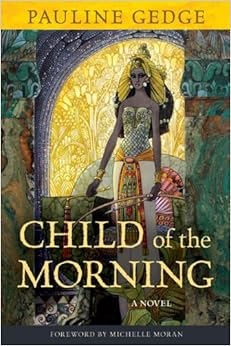Child of the Morning By
Pauline Gedge
Review by Katie Rose

It is
no secret to people who know me that I have a mild obsession with Ancient
Egypt. I have several books I plan to review for this blog that are about some
of the most powerful female rulers in history, and they all come from Egypt.
The first one I have decided to share is about the greatest female ruler of them
all; Hatshepsut. Egyptologists
agree that Hatshepsut was one of the greatest pharaohs who ever ruled Egypt.
Yes, I said pharaohs. Hatshepsut is unique in all of Egyptian history in that
she ruled Egypt not as a woman, but as a man. She ascended the throne as a male
ruler despite being female and portrayed herself as a man throughout her
kingdom to legitimize her right to the throne.
This novel was published in
1977, which means that it is extremely historically inaccurate. There are many
things Egyptologists thought they knew about Hatshepsut that we now know is
completely wrong. But I will get to that later. I should also point out that
marriage between siblings was taboo in Ancient Egypt just as it has been in
most places throughout history…unless you were royal. So yes, Hatshepsut
marries and has children with her brother. Gross? Yes. Unusual for the time?
Not at all. In fact it was expected.
There is a prayer that begins
the book. I highly recommend you read it as it was written by the actual woman
herself. This prayer introduces you to a major theme that drove Hatshepsut
throughout her life; that she was the daughter of the god Amun. Hatshepsut
firmly believed that her mother conceived her with the god Amun, who was using
her earthly father’s body. In this story Hatshepsut uses this idea as
justification for many of the things that she does.
Now for the story. It begins when
Hatshepsut is just a child with her brother and sister. Her older sister,
Neferukhebit, is loving and kind to both their bratty, lazy younger brother, as
well as to Hatshepsut. As the oldest, it is expected that Neferukhebit will
marry her brother and become his Great Royal Wife. This is because the
Egyptians believed that the blood line of the gods ran through women. It was a
position of great power. However, Neferu does not want that power. She fears
it. Hatshepsut is a wild young girl, lovely and charming, but very demanding.
She is by far her father’s favorite child, and he accommodates her like no
other Pharaoh would. Hatshepsut has a charisma that defines her personality.
Throughout her rise to the throne of Egypt, she makes many enemies, but there
is something about her beauty and intelligence that makes it difficult for
those who despise her to not also adore her as well. This is also the same for
the reader. There is something addicting about Hatshepsut. Sometimes you want
to dislike her, but you can’t. She is simply too magnificent.
The thing I love about this
version of Hatshepsut’s life is that she is a woman who wants power, craves it,
and is not afraid of showing it. Her desire to be pharaoh forces her to do things
she does not want to do, and that compromise her morality and makes the reader
question what kind of person she really is. Power becomes an obsession that
consumes her life. This is the type of story that has been told many, many
times about men, but rarely about women. Hatshepsut is ruthless and fiercely
clever. She was undeniably a woman, but she uses her more masculine traits to
her advantage. Hatshepsut was a fantastic ruler. She is also incredibly human,
despite her supposed godly origins. She suffers great personal loss, has a love
for the ages, and a daughter she adores. Above all she loves her people and
wants what is best for Egypt. She reigned over an era of peace and prosperity
that is only rivaled by a few other pharaohs in all of history.
Now for the downsides.
Inaccuracy. Oh the inaccuracy. At the
time this book was written the world believed a lot of things about Hatshepsut
that we now know are not true. The biggest error in this book is the
relationship between Hatshepsut and her nephew/step-son. At the time,
Egyptologists believed that Thutmose III hated his aunt, and that he was
responsible for the eventual attempt to erase her from history. We now know
that is not true. In fact, the evidence points to the idea that they actually
were very fond of each other and had a trusting relationship. The second
biggest fault is how Hatshepsut died. In the book she dies rather young from
nefarious causes. This was pure speculation on the part of Gedge as we did not
have her mummy at the time. Guess what? In 2011 we found her mummy (You have no
idea how excited I was when the news broke). We now know that Hatshepsut died
at a fairly old age from cancer.
Putting all that aside, I love
this book…seriously love this book. I am a stickler for historical accuracy
when it comes to these kind of things, and it takes a truly exceptional story
for me to be willing to ignore such inaccuracy. As I said before, Hatshepsut is
such a captivating and dynamic character that you can’t help but fall in love
with her. She is inspirational and terrifying, compassionate and brutal. Most
importantly to me, she was real. She was a woman who lived and breathed and
actually did the amazing things that are documented in this book.
Final Recommendation?
Read it. Hatshepsut’s rivals tried to erase her name from history and claim her
accomplishments as their own. Don’t let them win.



No comments:
Post a Comment